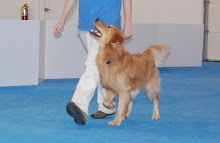We've determined good walking is hard to train dogs, and so have introduced a Polite Walking class at PosiDog.
But the part I've struggled with teaching, and still am, is the "leash handling" aspect.
I think part of the reason why I can make walking look so easy is that I'm fairly competent at leash handling. I rode horses for 10 years. I've spend hours and hours walking a difficult dog. I had no fenced yard for years. But I think the key in there is the horse experience.
It's difficult to cease forward motion when the dog is 'pulling' without coming to an abrupt halt. The tension needs to be released as soon as the dog is still. Not that this would function as R- for 98%+ of dogs, but the moving forward is R+ for most dogs and we want the dog to spend as little time on a tight leash as we can.
We want to be aware of our dog so we can continue to reinforce for meeting criteria. We want to know where he's going and what he's doing. But we also have to be aware of our environment. In class, we need to keep a safe distance from the other dogs and people and chairs. In the real world we need to avoid those things, raised sidewalk ledges, cars, squirrels, and other challenges.
We have to know what direction we're going in. A change of direction can be very helpful to maintain a light leash. But we don't want to do those abrupt 180's that have been popular forever. A curved change of direction can help carry a dog's motion to follow, but also prevent the tension and prevent reinforcing for tension.
Managing all our props is another skill. We have the leash. We have a treat pouch. We have to deliver treats. We might have a clicker. Or a flash light. Or a few more leashes too. We need to be able to do all of this while holding still, let alone with all the above challenges.
Specifically how we hold the leash can impact success. Do we put our hand through the loop? Do we grasp the leash? Have a loop over our thumb? Wrap it around our hand multiple times? What about all the extra leash! Being organized and having a good grip can help. And it's essential when you're walking with multiple dogs.
And I'm not even sure what else I'm doing and not doing...making teaching the skill hard. I've done videos of me walking. I've watched them. And I keep getting stuck. But it's just not transferring to students yet.
The biggest success has been "two fingers" when we talk about leash handling with head collars. That's how light and careful we are when a dog has tension on a head collar...we only use two fingers to change direction. That has stopped students from yanking heads around without realizing it. But it's not an aspect that has transfered well to buckle collars or front clip, due to the fact if the dog starts to /really/ pull, two fingers aren't enough to maintain position.
Sunday, May 2, 2010
Subscribe to:
Post Comments (Atom)




No comments:
Post a Comment